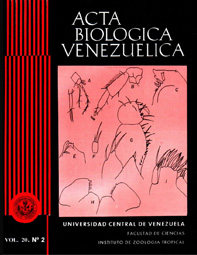THE BIOLOGY OF THE OPOSSUM (DIDELPHIS MARSUPIALIS) IN URBANIZED ENVIRONMENTS FROM NORTHERN VENEZUELA
Palabras clave:
Opossum, body size, age group, habitat, abundance, food habits, breeding activity, suburban and urban environments, Northern Venezuela.Resumen
This paper assesses the opossum (Didelphis marsupialis) biology, relative abundance and reproductive cycle and attempts to address the issue of the role it plays in urban environments at Caracas Metropolitan Area (CMA), Northern Venezuela.The opossum is commonly found in any patch of vegetation in urbanized areas. Relative abundance ranged from 6.3 to 12.5 and from 4 to 20 individuáis per 100 traps-nights in the urban and suburban áreas, respectively. The abundance is higher than the ones recorded for other Venezuelan localities. Dietary composition is significantly different (Mann-Whitncy U-test, P < 0.05) between seasons, by volume and frequency of occurrence. Data showed that the opossum is an opportunist feeder that behaves as carnivorous or insectivorous in the wet season. It may play an imporlant sanitation role by consuming slugs, centipedes, cockroaches and carrion of roadkills. Average litter size recorded was 6.8 (S=1.99, N=20), ranging from 4 to 10 young. Breeding activity may occur from January throughout November. producing 2 litters annually. The reproductive cycle is basically the same as in natural environments. The availability of natural forest around the city, fragments of forest patches and greenspaces within urban areas, food resources, absence or few predators, and a stable climate might explained the opossum success at CMA.


